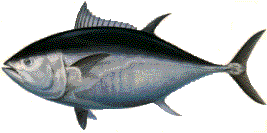
Grades 9-12

Don't have an account yet? Sign up for free
Don't have an account yet? Sign up for free


Okay, so your tuna fish sandwich probably isn’t worth a couple grand. It’s most likely made with a type of tuna called albacore. But, on the docks in Tokyo different kind of tuna, related to the stuff in your sandwich, is sold for $70,000 dollars a fish. The Japanese praise the bluefin tuna, or maguro, as a delicacy.
 Okay, so your tuna fish sandwich probably isn’t worth a couple grand. It’s most likely made with a type of tuna called albacore. But, on the docks in Tokyo different kind of tuna, related to the stuff in your sandwich, is sold for $70,000 dollars a fish. The Japanese praise the blue fin tuna, or maguro, as a delicacy. To see what a maguro looks like and how it is eaten, visit https://www.sushifaq.com/sushi-sashimi-info/sushi-item-profiles/sushi-items-maguro-tuna/.
Okay, so your tuna fish sandwich probably isn’t worth a couple grand. It’s most likely made with a type of tuna called albacore. But, on the docks in Tokyo different kind of tuna, related to the stuff in your sandwich, is sold for $70,000 dollars a fish. The Japanese praise the blue fin tuna, or maguro, as a delicacy. To see what a maguro looks like and how it is eaten, visit https://www.sushifaq.com/sushi-sashimi-info/sushi-item-profiles/sushi-items-maguro-tuna/.
Is maguro made the way you would make tuna fish salad? If not, how is maguro served? [No, maguro is served raw in small slices. It can be eaten alone (sashimi), rolled with seaweed (teppamaki), or on rice (nigiri-zushi).]
There is another big difference between maguro and canned tuna–the price. In this EconomicsMinute, we are going figure out why blue fin tuna goes for tens of thousands of dollars, while a can of its cousin is available at the supermarket for $1.99.
Two economic forces determine the market price of blue fin tuna: demand and supply. The interaction of supply and demand determine the price of almost all of the stuff you buy, from ice cream to basketballs.
Let’s look at the concept, "quantity demanded." The quantity demanded is the amount of a good or service that consumers plan to buy during a given time period at a particular price. For example, if the price is $2 for a can of tuna, the quantity demanded might be 1 million units. However, if the price is lowered to $1.50 per can, then the quantity demanded would increase to maybe 1.5 million. At lower prices, quantity demanded increases. At higher prices, quantity demanded decreases. In this case, the quantity demanded of tuna would be the number of fish consumers plan to buy from each catch. This amount will change depending on the price of the blue fin. If Japanese consumers can buy a tuna for 12 yen (one U.S. dime), they will be dining on maguro every night. But, if the consumers have to pay 18.8 million yen ($140,000 U.S. dollars), they’ll pass on the tuna.
However, a lower price does not increase quantity demanded just because consumers are looking for a bargain. As more blue fins become available to consumers, the benefit that consumers get from one more fish decreases. This is the idea of diminishing marginal benefits.
Imagine you are a sushi lover. How much sushi would you buy at each given price? As you eat more and more tuna, the additional benefits you receive and your willingness to pay for one more fish decrease. The higher the quantity eaten, the less you are willing to pay for one more.
[Note to teacher: This lesson is intended to serve as a culminating activity for the investigation of supply and demand.]
Activity 1
Economists describe the relationship between quantity demanded and the price of a good as the demand for a good. A demand curve expresses this relationship. In order to generate your demand curve for maguro complete the following activity by entering the amount you would be willing to eat at each price. Use the arrows to navigate.
The line you have just generated represents the entire relationship between the quantity demanded and the price of a good. This line is the demand for bluefin tuna. A point on this line is a quantity demanded at a particular price. What is the general shape of a demand curve? [The demand curve is downward sloping.] Why is it shaped that way? [Consumers face diminishing marginal benefits.]
Demand is only half the story behind why you can't trade your tuna fish sandwich for a new car. The supply side of the market still needs to be explained. Similar to demand and quantity demanded, there is supply and quantity supplied. Quantity supplied is the amount of a good that a producer plans to sell in a given period at a particular price. In this case, the quantity supplied of tuna fish would be the number of fish a fisherman plans to sell from each boat load. This amount will change depending on the price he believes he can get for his catch. If the Japanese fisherman thinks he is going to get 12 yen (one U.S. dime) per fish, he isn't going to go out fishing. But, if the fisherman thinks he is going to get 9.4 million yen per fish ($88,000 U.S. Dollars), he's already out on the ocean. However, a higher price does not increase quantity supplied just because the fisherman wants more money. As more bluefins are caught, the cost to the fisherman of catching one more fish increases. This is the idea of increasing marginal cost.
Imagine you are the fisherman. How would you set your price for fish? The price you sell your fish for depends on how much it costs you to catch it. As the quantity of bluefins on the market increases, the amount in the sea decreases and it is more expensive for you to find and catch a bluefin. Your marginal costs are increasing. Therefore, you will have to get more money at the dock to cover your costs.
Activity 2
Economists describe the relationship between quantity supplied and the price of a good as the supply of a good. A supply curve expresses this relationship. Generate your supply curve by completing the following activity by entering the amount you would be willing to sell at each price. Use the arrows to navigate.
The line you just generated represents the entire relationship between the quantity supplied and the price of a good. This line is the supply of bluefin tuna. A point on that line is a quantity supplied at a particular price. What is the general shape of a supply curve? [The supply curve is upward sloping.] Why is it shaped that way? [Because producers are facing increasing marginal costs.]
Now, to see how supply and demand come together to determine price, imagine that you could put the two graphs on top of each other. There would be some price and some quantity where the two curves intersect. These price and quantity numbers are the equilibrium price and the equilibrium quantity. A competitive open market moves towards an equilibrium price and equilibrium quantity that best suits that largest number of producers and consumers. At this equilibrium point, marginal benefits equal marginal costs.
But why does a bluefin tuna cost more than a car, while a can of tuna costs less than a magazine? The Sushi Homepage and the National Geographic Society's Xpeditions point out that generally the Japanese love sushi. They are willing to pay a higher price for sushi at every quantity demanded. Why would they be more willing to pay? To the sushi lover there are few substitute goods for maguro. A substitute is a good that can be used in place of another good. Conversely, you pay less for a can of tuna because there are many available substitutes. What are the substitutes for tuna fish? What would you eat if the price of tuna went up by $5.00? [You could eat shrimp salad, chicken salad, salami, bologna, roast beef, yogurt, veggies, almost any other typical lunch food.] However, to the maguro lover, it is different; an increase in the price of the fish does not immediately make him or her turn to other fish.
Now let's look at the supply side of why a bluefin tuna is more expensive than a truck. To see what is happening to the physical supply of bluefin tuna, check out http://www.nbcnews.com/id/5428979/ns/us_news-environment/t/bluefin-tuna-losing-battle-survival/#.XS3tmvlKjcs .
Direct your students to the World Wildlife Federation's information page on tuna and ask them to read about how tuna are caught and the threats facing this species.

Grades 9-12

Grades 3-5

Marginal Revolution University
Grades 9-12

Grades 9-12
